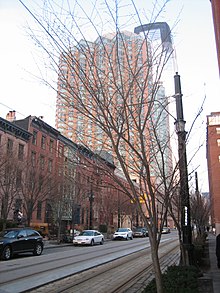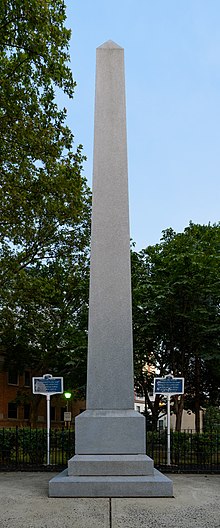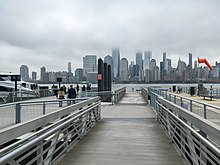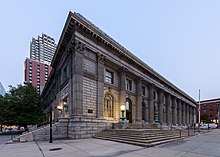Paulus Hook

Paulus Hook is a community on the Hudson River waterfront in Jersey City, New Jersey. It is located one mile (1.5 kilometres) across the river from Manhattan. The name Hook comes from the Dutch word "hoeck", which translates to "point of land." This "point of land" has been described as an elevated area, the location of which today is bounded by Montgomery, Hudson, Dudley, and Van Vorst Streets.
The neighborhood's main street is the north- and south-running Washington Street. The waterfront of Paulus Hook is located along the basin of the
History
Settlement


The location that today is Paulus Hook originally was called Arressick or Arisheck Island by the earliest settlers after a corrupted Lenape term, possibly from Kaniskeck, meaning a long, grassy marsh, or meadow.[1]
17th century
The location that represents present-day Paulus Hook was originally part of a tract of land purchased by
The first settlement at Paulus Hook was in 1633
On February 25, 1643, 100 Native American Indians were massacred at or in the vicinity of Paulus Hook (the
Until the
In 1672, the
18th century
In July 1764,
American Revolutionary War

In 1776,
In mid-summer 1779, a flamboyant 23-year-old
The attacking Patriots succeeded in damaging the fort and took 158 British prisoners, but were unable to destroy the fort and spike its cannons.[11] As daytime arrived, Lee decided that prudent action demanded that the Patriots withdraw before the British forces from New York could cross the river. Paulus Hook remained in British hands until after the war but the battle was a small strategic victory for the forces of independence as it forced the British to abandon their plans for taking rebel positions in the New York area.
On November 22, 1783, the British evacuated Paulus Hook and sailed home.[12] This was three days before they left New York on Evacuation Day, November 25, 1783. While the battle occupies only a small portion of U.S. Revolutionary War history, it is an important part of the history of New Jersey and New Jersey's role in the American Revolution, and holds an even more important place in the history of the neighborhood. A monument was erected in 1903 to memorialize the battle.
19th century
Paulus Hook subsequently became a major road and rail head for traffic along the
Paulus Hook was founded in 1894 by Cornelia Foster Bradford and named after John Greenleaf Whittier.
20th century
Whittier House, also named after John Greenleaf Whittier, was the first settlement house in the state.[13][14]
21st century
During the 21st century the arrival of the Hudson–Bergen Light Rail, a construction boom following the attacks of September 11,[15] investments in Liberty State Park and the expansion of the area's ferry connections to lower Manhattan all helped to propel a process of gentrification.
Today, real estate prices in Paulus Hook are generally higher than in surrounding neighborhoods, which include Liberty Harbor, the
On October 29, 2012, Paulus Hook was devastated during Hurricane Sandy, with significant flooding occurring throughout the neighborhood.[17]
See also
References
- ^ "Proceedings of the New York State Historical Association" Volume 6. The Association, 1906
- Fort Orange for themselves, he "immediately had the land below, opposite Fort Amsterdam, where the Indians are compelled to cross to the fort with their beavers, registered for himself, and called it Pavonia." (J. F. Jameson, Narratives of New Netherland, p. 210.)
- ^ Free Public Library of Jersey City (1909). From canoe to tunnel
 . A. J. Doan. p. 15 [scan]
. A. J. Doan. p. 15 [scan]  .
.
- ^ A Map of that part of the Town of Jersey, Commonly called Powles Hook [scan]
 (Map). P. Desobry's Lith. 1804.
(Map). P. Desobry's Lith. 1804.
- ^ NJCU: Jersey City A to Z/Paulus Hook
- ^ "Jersey City History - Old Bergen - Chapter VIII". www.cityofjerseycity.org. Retrieved June 24, 2017.
- ^ "Earliest known Manhattan map made in 1639" (PDF). The New York Times. March 25, 1917. Retrieved May 25, 2017.
- OCLC 1726713.
- OCLC 459078913.
- ISBN 978-0823219544.
- ^ "Recalling Paulus Hook; Jersey City's Revolutionary Battle. Major Harry Lee's Dashing Exploit One Hundred Years Ago--His Attack Upon And Capture Of A British Garrison--Yesterday's Commemorative Exercises" (PDF). The New York Times. August 20, 1879.
- OCLC 1742471.
- ^ Woods, Robert Archey; Kennedy, Albert Joseph (1911). Handbook of Settlements (Public domain ed.). Charities Publication Committee. pp. 161–63. Retrieved April 27, 2022.
 This article incorporates text from this source, which is in the public domain.
This article incorporates text from this source, which is in the public domain.
- ^ Bibliography of College, Social, University and Church Settlements (Public domain ed.). 1900. pp. 28–29. Retrieved April 27, 2022.
 This article incorporates text from this source, which is in the public domain.
This article incorporates text from this source, which is in the public domain.
- ^ Gelsi, Steve (February 9, 2002). "Wall Street moves west". Market Watch. Retrieved May 21, 2013.
- ^ "About the HPHA". Historic Paulus Hook Association. Retrieved October 15, 2021.
- ^ Pompeo, Joe (November 2, 2012). "In Jersey City's Paulus Hook, once-coveted brownstone garden apartments are mucked out, and reconsidered". Capital New York. Archived from the original on November 4, 2012.

